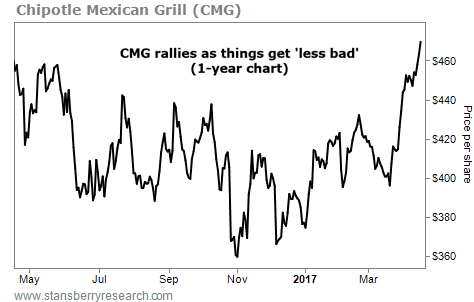| Home | About Us | Resources | Archive | Free Reports | Market Window |
Are You 'Stock Shy'? Don't BeBy
Wednesday, April 19, 2017
You're probably nervous about buying stocks...
The current eight-year-long bull market – which came after a memorable and painful crash – has most people nervous.
This is a problem. Nerves don't help you make money or protect what you have. They only add to the likelihood that you'll make unnecessary trading mistakes.
And nobody wants that.
Another problem with being "stock shy" is that we're in a bull market... And stocks are one of the best places to make money today.
Today, I aim to help you lose the nerves. The best way to do that is to have a well-thought-out plan for dealing with risk. So below, I'll share one of the most powerful ways you can deal with risk this year...
It starts with stop losses, includes position sizing, and ends with scaling in to positions. These are three big ideas... So let's get started.
A stop loss is a predetermined point at which you'll sell a trading position... no questions asked. Stop losses are designed to limit risk and to remove emotions from your trading decisions.
I won't get into the nitty-gritty of how to choose a stop loss here. But we can break down stop losses into groups, by percentages...
For example, if you think that your timing on a trade is good or that the trade doesn't need much "wiggle room," you might be comfortable using a tight stop loss that's 10% or less below your purchase price. If you think the stock will be volatile but has huge upside potential, you might prefer to use a wide stop loss that's 20% or more below your purchase price.
I suggest creating three stop-loss groups based on the risk to your initial capital. Maybe you label them "tight," "moderate," and "wide" stop losses. Each of these groups will be appropriate for certain types of trades.
Next, consider your position size. This is the amount of money you put into a stock. In general, you should feel comfortable putting more money into positions that you view as safe and likely to be profitable... and less money into riskier speculations, even if they have enormous upside potential.
For example, if consumer-electronics giant Apple (AAPL) is trading at its cheapest valuation in years (as it was last February), you should consider taking a large position size. It's the largest company in the world, and it earns extraordinary profits and free cash flows.
Junior gold miners, on the other hand, are more like lottery tickets. You could make 10 times your money or more if a trade works out. But even if you do a deep analysis of a company, you may still lose money. Plus, junior gold-mining stocks are guaranteed to be volatile. So you probably shouldn't put too large a percentage of your wealth into any one such stock.
Finally, scaling in means buying a portion of your planned position size initially and buying another portion (or portions) later on. I usually suggest adding to a position only after you're showing profits on the initial position. This way, you can keep your risk to a minimum.
Those are the three ideas you need to understand. Here's how you can use them together in your trading...
If you're making a trade with a tight stop loss (maybe 10% or less), you may want to take a full position size right off the bat. After all, a 10% loss isn't too bad, even with a relatively large position size.
If you're making a trade with a moderate stop loss, you may want to take a half position. This way, you'll risk just half the amount you would on a full position. Then, you can add the other half position once you're sitting on gains and can comfortably tighten your stop loss.
If you're making a trade with a wide stop loss, you may want to take a one-third position size. Just like with your half positions, you can add to one-third positions after the trade moves in your favor.
You don't have to follow this strategy to a T... But you can use it, or something similar, as a guideline. Risk less up front... And have more confidence in your trades.
Remember, we're in a bull market. Stocks could continue higher for longer than we can imagine.
Good trading,
Ben Morris
Further Reading:
Now is not the time to be "stock shy." Investors are starting to lose their fear of the markets... And according to history, it's a sign that the biggest gains of this bull market are about to kick off. Learn more here: The 'Melt Up' Is Here – Investor Optimism Hits a 17-Year High.
"When it comes to investment opportunities, most of us do not act rationally," Mark Ford wrote recently. And emotional investing can lead you to take big risks in the markets. Learn how a few simple guidelines can help you trade smarter and minimize your risk, right here: Why Investors Are No Better Than Lab Monkeys.
Market NotesA 'BAD TO LESS BAD' RALLY FOR THIS FORMER MARKET DARLING One of the most popular restaurant chains in the U.S. is finally starting to turn things around...
Chipotle Mexican Grill (CMG) used to be one of the fastest-growing chains in the U.S. But after a handful of concerns regarding foodborne-illness outbreaks, analysts downgraded the stock as customers chose other options. Same-store sales plunged more than 20%. But that downtrend is slowing...
Last quarter, Chipotle's same-store sales fell only 5%. The company is still a high-quality, well-run business and continues to turn an impressive profit on a per-location basis. And now, its shares have rallied as things have gone from "bad to less bad."
As the food-safety concerns have subsided, customers are returning to their favorite burrito chain. Although shares are still well off their 2015 highs, the stock has rebounded more than 30% since its November lows. It's a reminder that even the best businesses suffer temporary setbacks from time to time...
 |
Recent Articles
|



